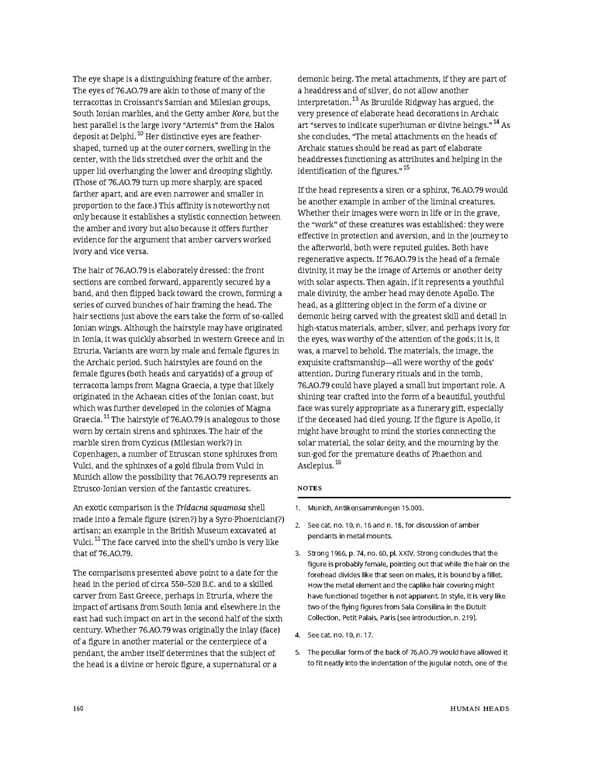The eye shape is a distinguishing feature of the amber. demonic being. The metal attachments, if they are part of The eyes of 76.AO.79 are akin to those of many of the a headdress and of silver, do not allow another terracottas in Croissant’s Samian and Milesian groups, interpretation.13 As Brunilde Ridgway has argued, the South Ionian marbles, and the Getty amber Kore, but the very presence of elaborate head decorations in Archaic best parallel is the large ivory “Artemis” from the Halos art “serves to indicate superhuman or divine beings.”14 As deposit at Delphi.10 Her distinctive eyes are feather- she concludes, “The metal attachments on the heads of shaped, turned up at the outer corners, swelling in the Archaic statues should be read as part of elaborate center, with the lids stretched over the orbit and the headdresses functioning as attributes and helping in the upper lid overhanging the lower and drooping slightly. identification of the figures.”15 (Those of 76.AO.79 turn up more sharply, are spaced farther apart, and are even narrower and smaller in If the head represents a siren or a sphinx, 76.AO.79 would proportion to the face.) This affinity is noteworthy not be another example in amber of the liminal creatures. only because it establishes a stylistic connection between Whether their images were worn in life or in the grave, the amber and ivory but also because it offers further the “work” of these creatures was established: they were evidence for the argument that amber carvers worked effective in protection and aversion, and in the journey to ivory and vice versa. the afterworld, both were reputed guides. Both have regenerative aspects. If 76.AO.79 is the head of a female The hair of 76.AO.79 is elaborately dressed: the front divinity, it may be the image of Artemis or another deity sections are combed forward, apparently secured by a with solar aspects. Then again, if it represents a youthful band, and then flipped back toward the crown, forming a male divinity, the amber head may denote Apollo. The series of curved bunches of hair framing the head. The head, as a glittering object in the form of a divine or hair sections just above the ears take the form of so-called demonic being carved with the greatest skill and detail in Ionian wings. Although the hairstyle may have originated high-status materials, amber, silver, and perhaps ivory for in Ionia, it was quickly absorbed in western Greece and in the eyes, was worthy of the attention of the gods; it is, it Etruria. Variants are worn by male and female figures in was, a marvel to behold. The materials, the image, the the Archaic period. Such hairstyles are found on the exquisite craftsmanship—all were worthy of the gods’ female figures (both heads and caryatids) of a group of attention. During funerary rituals and in the tomb, terracotta lamps from Magna Graecia, a type that likely 76.AO.79 could have played a small but important role. A originated in the Achaean cities of the Ionian coast, but shining tear crafted into the form of a beautiful, youthful which was further developed in the colonies of Magna face was surely appropriate as a funerary gift, especially Graecia.11 The hairstyle of 76.AO.79 is analogous to those if the deceased had died young. If the figure is Apollo, it worn by certain sirens and sphinxes. The hair of the might have brought to mind the stories connecting the marble siren from Cyzicus (Milesian work?) in solar material, the solar deity, and the mourning by the Copenhagen, a number of Etruscan stone sphinxes from sun-god for the premature deaths of Phaethon and Vulci, and the sphinxes of a gold fibula from Vulci in Asclepius.16 Munich allow the possibility that 76.AO.79 represents an Etrusco-Ionian version of the fantastic creatures. NOTES An exotic comparison is the Tridacna squamosa shell 1. Munich, Antikensammlungen 15.003. made into a female figure (siren?) by a Syro-Phoenician(?) 2. See cat. no. 10, n. 16 and n. 18, for discussion of amber artisan; an example in the British Museum excavated at pendants in metal mounts. Vulci.12 The face carved into the shell’s umbo is very like that of 76.AO.79. 3. Strong 1966, p. 74, no. 60, pl. XXIV. Strong concludes that the figure is probably female, pointing out that while the hair on the The comparisons presented above point to a date for the forehead divides like that seen on males, it is bound by a fillet. head in the period of circa 550–520 B.C. and to a skilled How the metal element and the caplike hair covering might carver from East Greece, perhaps in Etruria, where the have functioned together is not apparent. In style, it is very like impact of artisans from South Ionia and elsewhere in the two of the flying figures from Sala Consilina in the Dutuit east had such impact on art in the second half of the sixth Collection, Petit Palais, Paris (see introduction, n. 219). century. Whether 76.AO.79 was originally the inlay (face) 4. See cat. no. 10, n. 17. of a figure in another material or the centerpiece of a pendant, the amber itself determines that the subject of 5. The peculiar form of the back of 76.AO.79 would have allowed it the head is a divine or heroic figure, a supernatural or a to fit neatly into the indentation of the jugular notch, one of the 160 HUMAN HEADS
 Ancient Carved Ambers in the J. Paul Getty Museum Page 169 Page 171
Ancient Carved Ambers in the J. Paul Getty Museum Page 169 Page 171